Utilizing Cymbopogon Proximus Grass Extract for Green Synthesis of Zinc Oxide Nanorod Needles in Dye Degradation Studies
Abstract
:1. Introduction
2. Results and Discussion
3. Experimental Methods
3.1. Green Synthesis and Characterization of Zinc Oxide Nanorod Needles
3.2. Photocatalytic Activity Study
4. Conclusions
Author Contributions
Funding
Institutional Review Board Statement
Informed Consent Statement
Data Availability Statement
Acknowledgments
Conflicts of Interest
References
- More, P.; Inamdar, V.; Suresh, S.; Dindorkar, S.; Peddakolmi, S.; Jain, K.; Khona, N.; Khatoon, S.; Patange, S. Synthesis of zinc oxide nanoparticles using Chrysopogonzizanioides grass extract, its applications in photodegradation and antimicrobial activity. J. Mater. Sci. Mater. Electron. 2021, 32, 20725–20741. [Google Scholar] [CrossRef]
- Han, G.; Xu, F.; Cheng, B.; Li, Y.; Yu, J.; Zhang, L. Enhanced photocatalytic H2O2 production over inverse opal ZnO@ polydopamine S-scheme heterojunctions. Acta Phys. Chim. Sin. 2022, 38, 2112037. [Google Scholar] [CrossRef]
- Alprol, A.E.; Mansour, A.T.; El-Beltagi, H.S.; Ashour, M. Algal Extracts for Green Synthesis of Zinc Oxide Nanoparticles: Promising Approach for Algae Bioremediation. Materials 2023, 16, 2819. [Google Scholar] [CrossRef]
- Sharma, D.K.; Shukla, S.; Sharma, K.K.; Kumar, V. A review on ZnO: Fundamental properties and applications. Mater. Today Proc. 2022, 49, 3028–3035. [Google Scholar] [CrossRef]
- Gherbi, B.; Laouini, S.E.; Meneceur, S.; Bouafia, A.; Hemmami, H.; Tedjani, M.L.; Thiripuranathar, G.; Barhoum, A.; Menaa, F. Effect of pH value on the bandgap energy and particles size for biosynthesis of ZnO nanoparticles: Efficiency for photocatalytic adsorption of methyl orange. Sustainability 2022, 14, 11300. [Google Scholar] [CrossRef]
- Ko, S.C.; Kim, Y.C.; Lee, S.S.; Choi, S.H.; Kim, S.R. Micromachined piezoelectric membrane acoustic device. Sens. Actuators A Phys. 2003, 103, 130–134. [Google Scholar] [CrossRef]
- Rodnyi, P.A.; Khodyuk, I.V. Optical and luminescence properties of zinc oxide. Opt. Spectrosc. 2011, 111, 776–785. [Google Scholar] [CrossRef]
- Chandrasekaran, S.; Anusuya, S.; Anbazhagan, V. Anticancer, anti-diabetic, antimicrobial activity of zinc oxide nanoparticles: A comparative analysis. J. Mol. Struct. 2022, 1263, 133139. [Google Scholar] [CrossRef]
- Omran, A.M. Characterization of green route synthesized zinc oxide nanoparticles using Cyperus rotundus rhizome extract: Antioxidant, antibacterial, anticancer and photocatalytic potential. J. Drug Deliv. Sci. Technol. 2023, 79, 104000. [Google Scholar] [CrossRef]
- Kumar, S.; Bhushan, P.; Bhattacharya, S. Fabrication of nanostructures with bottom-up approach and their utility in diagnostics, therapeutics, and others. Environ. Chem. Med. Sens. 2018, 167–198. [Google Scholar] [CrossRef]
- Tulinski, M.; Jurczyk, M. Nanomaterials synthesis methods. Metrol. Stand. Nanotechnol. Protoc. Ind. Innov. 2017, 75–98. [Google Scholar] [CrossRef]
- Krishnia, L.; Thakur, P.; Thakur, A. Synthesis of nanoparticles by physical route. In Synthesis and Applications of Nanoparticles; Springer: Singapore, 2022; pp. 45–59. [Google Scholar]
- Hernández-Díaz, J.A.; Garza-García, J.J.; Zamudio-Ojeda, A.; León-Morales, J.M.; López-Velázquez, J.C.; García-Morales, S. Plant-mediated synthesis of nanoparticles and their antimicrobial activity against phytopathogens. J. Sci. Food Agric. 2021, 101, 1270–1287. [Google Scholar] [CrossRef] [PubMed]
- Avoseh, O.; Oyedeji, O.; Rungqu, P.; Nkeh-Chungag, B.; Oyedeji, A. Cymbopogon species; ethnopharmacology, phytochemistry and the pharmacological importance. Molecules 2015, 20, 7438–7453. [Google Scholar] [CrossRef]
- El-Nezhawy, A.O.H.; Maghrabi, I.A.; Mohamed, K.M.; Omar, H.A. Cymbopogon proximus extract decreases L-NAME-induced hypertension in rats. Int. J. Pharm. Sci. Rev. Res. 2014, 27, 66–69. [Google Scholar]
- El Tahir, K.; Abdel-Kader, M. Chemical and pharmacological study of Cymbopogon proximus volatile oil. Res. J. Med. Plant 2008, 2, 53–60. [Google Scholar]
- Kuwahara, K.; Nishikimi, T.; Nakao, K. Transcriptional regulation of the fetal cardiac gene program. J. Pharmacol. Sci. 2012, 119, 198–203. [Google Scholar] [CrossRef] [PubMed]
- Mansour, H.A.; Newairy, A.S.A.; Yousef, M.I.; Sheweita, S.A. Biochemical study on the effects of some Egyptian herbs in alloxan-induced diabetic rats. Toxicology 2002, 170, 221–228. [Google Scholar] [CrossRef] [PubMed]
- Ibrahim, F.Y.; El-Khateeb, A.Y. Effect of herbal beverages of Foeniculum vulgare and Cymbopogon proximus on inhibition of calcium oxalate renal crystals formation in rats. Ann. Agric. Sci. 2013, 58, 221–229. [Google Scholar] [CrossRef]
- Althurwi, H.N.; Abdel-Kader, M.S.; Alharthy, K.M.; Salkini, M.A.; Albaqami, F.F. Cymbopogon proximus essential oil protects rats against isoproterenol-induced cardiac hypertrophy and fibrosis. Molecules 2020, 25, 1786. [Google Scholar]
- Awad, M.A.G.; Hendi, A.A.; Ortashi, K.M.O.; Aldalbahi, A.K.; Alnamlah, R.A. Synthesis of Zinc Oxide Nanoparticles Using Cymbopogon Proximus Extract. U.S. Patent No. 10,358,356; U.S. Patent and Trademark Office: Washington, DC, USA, 23 July 2019. [Google Scholar]
- Awad, M.A.; Alanazi, M.M.; Hendi, A.A.; Virk, P.; Alrowaily, A.W.; Bahlool, T.; Alhakami, F.S.; Aouaini, F.; Ibrahim, E.M. Potential Role of ‘Green’Synthesized Titanium Dioxide Nanoparticles in Photocatalytic Applications. Crystals 2022, 12, 1639. [Google Scholar] [CrossRef]
- Jeyapratha, J.; Christina, C.; Chandra Lekha, N. Green synthesis of copper nanoparticles from the flower extract of Ipomea pes-caprae collected from Thoothukudi coastal areas. Int. J. Adv. Sci. Res. Manag. 2022. [Google Scholar]
- Singh, K.; Kaur, H.; Sharma, P.K.; Singh, G.; Singh, J. ZnO and cobalt decorated ZnO NPs: Synthesis, photocatalysis and antimicrobial applications. Chemosphere 2023, 313, 137322. [Google Scholar] [CrossRef] [PubMed]
- Gnanamozhi, P.; Monamary, A.; Jereil, S.D.; Pauline, J.E.; Ratnam, J.A.O.; Ganeshkumar, A.; Pandiyan, V.; Alothman, A.A.; Alshgari, R.A.; Govindasamy, M. Effective photocatalytic degradation of methylene blue (MB) and reactive red 120 (RR120) using Al substituted ZnO nanoparticles. Surf. Interfaces 2023, 41, 103203. [Google Scholar] [CrossRef]
- Sangeetha, G.; Rajeshwari, S.; Venckatesh, R. Green synthesis of zinc oxide nanoparticles by aloe barbadensis miller leaf extract: Structure and optical properties. Mater. Res. Bull. 2011, 46, 2560–2566. [Google Scholar] [CrossRef]
- Shankar, S.S.; Rai, A.; Ahmad, A.; Sastry, M. Rapid synthesis of Au, Ag, and bimetallic Au core–Ag shell nanoparticles using Neem (Azadirachta indica) leaf broth. J. Colloid Interface Sci. 2004, 275, 496–502. [Google Scholar] [CrossRef]
- Kannan, S.; Subiramaniyam, N.P.; Sathishkumar, M. A novel green synthesis approach for improved photocatalytic activity and antibacterial properties of zinc sulfide nanoparticles using plant extract of Acalypha indica and Tridax procumbens. J. Mater. Sci. Mater. Electron. 2020, 31, 9846–9859. [Google Scholar] [CrossRef]
- Smitha, S.L.; Nissamudeen, K.M.; Philip, D.; Gopchandran, K.G. Studies on surface plasmon resonance and photoluminescence of silver nanoparticles. Spectrochim. Acta Part A Mol. Biomol. Spectrosc. 2008, 71, 186–190. [Google Scholar] [CrossRef] [PubMed]
- Sosa, I.O.; Noguez, C.; Barrera, R.G. Optical properties of metal nanoparticles with arbitrary shapes. J. Phys. Chem. B 2003, 107, 6269–6275. [Google Scholar] [CrossRef]
- Gurylev, V. Nanostructured photocatalyst via defect engineering; Springer International Publishing: Cham, Switzerland, 2021. [Google Scholar]
- Djurišić, A.B.; Leung, Y.H. Optical properties of ZnO nanostructures. Small 2006, 2, 944–961. [Google Scholar] [CrossRef]
- Raji, R.; Gopchandran, K.G. ZnO nanostructures with tunable visible luminescence: Effects of kinetics of chemical reduction and annealing. J. Sci. Adv. Mater. Devices 2017, 2, 51–58. [Google Scholar] [CrossRef]
- Vanheusden, K.; Seager, C.H.; Warren, W.T.; Tallant, D.R.; Voigt, J.A. Correlation between photoluminescence and oxygen vacancies in ZnO phosphors. Appl. Phys. Lett. 1996, 68, 403–405. [Google Scholar] [CrossRef]
- Chandrappa, K.G.; Venkatesha, T.V. Electrochemical synthesis and photocatalytic property of zinc oxide nanoparticles. Nano-Micro Lett. 2012, 4, 14–24. [Google Scholar] [CrossRef]
- Yue, L.; Qi, S.; Wang, J.; Cai, J.; Xin, B. Controllable biosynthesis and characterization of α-ZnS and β-ZnS quantum dots: Comparing their optical properties. Mater. Sci. Semicond. Process. 2016, 56, 115–118. [Google Scholar] [CrossRef]
- Deka, D.C.; Kalita, A.; Bardaloi, S.; Kalita, M.P. Influence of capping agent on structural, optical and photocatalytic properties of ZnS nanocrystals. J. Lumin. 2019, 210, 269–275. [Google Scholar] [CrossRef]
- Stoyanova, D.; Stambolova, I.; Blaskov, V.; Georgieva, P.; Shipochka, M.; Zaharieva, K.; Dimitrov, O.; Markov, P.; Dyakova, V.; Kostova, Y.; et al. Modified approach using Mentha arvensis in the synthesis of ZnO nanoparticles—textural, structural, and photocatalytic properties. Appl. Sci. 2022, 12, 1096. [Google Scholar] [CrossRef]
- Raza, N.; Raza, W.; Madeddu, S.; Agbe, H.; Kumar, R.V.; Kim, K.H. Synthesis and characterization of amorphous precipitated silica from alkaline dissolution of olivine. RSC Adv. 2018, 8, 32651–32658. [Google Scholar] [CrossRef]
- Maraghechi, H.; Avet, F.; Wong, H.; Kamyab, H.; Scrivener, K. Performance of Limestone Calcined Clay Cement (LC 3) with various kaolinite contents with respect to chloride transport. Mater. Struct. 2018, 51, 1–17. [Google Scholar]
- Özgür, Ü.; Alivov, Y.I.; Liu, C.; Teke, A.; Reshchikov, M.A.; Doğan, S.; Avrutin, V.C.S.J.; Cho, S.J.; Morkoç, A.H. A comprehensive review of ZnO materials and devices. J. Appl. Phys. 2005, 98, 041301. [Google Scholar]
- Hessien, M.; Da’na, E.; Kawther, A.L.; Khalaf, M.M. Nano ZnO (hexagonal wurtzite) of different shapes under various conditions: Fabrication and characterization. Mater. Res. Express. 2019, 6, 085057. [Google Scholar] [CrossRef]
- Nguyen, L.T.; Nguyen, L.T.; Duong, A.T.; Nguyen, B.D.; Quang Hai, N.; Chu, V.H.; Nguyen, T.D.; Bach, L.G. Preparation, characterization and photocatalytic activity of La-doped zinc oxide nanoparticles. Materials 2019, 12, 1195. [Google Scholar] [CrossRef]
- Narendra Kumar, H.K.; Chandra Mohana, N.; Nuthan, B.R.; Ramesha, K.P.; Rakshith, D.; Geetha, N.; Satish, S. Phyto-mediated synthesis of zinc oxide nanoparticles using aqueous plant extract of Ocimum americanum and evaluation of its bioactivity. SN Appl. Sci. 2019, 1, 651. [Google Scholar] [CrossRef]
- Awan, S.S.; Khan, R.T.; Mehmood, A.; Hafeez, M.; Abass, S.R.; Nazir, M.; Raffi, M. Ailanthus altissima leaf extract mediated green production of zinc oxide (ZnO) nanoparticles for antibacterial and antioxidant activity. Saudi J. Biol. Sci. 2023, 30, 103487. [Google Scholar]
- Dinesh, V.P.; Biji, P.; Ashok, A.; Dhara, S.K.; Kamruddin, M.; Tyagi, A.K.; Raj, B. Plasmon-mediated, highly enhanced photocatalytic degradation of industrial textile dyes using hybrid ZnO@ Ag core–shell nanorods. RSC Adv. 2014, 4, 58930–58940. [Google Scholar] [CrossRef]
- Sagar Raut, D.P.; Thorat, R. Green synthesis of zinc oxide (ZnO) nanoparticles using Ocimum Tenuiflorum leaves. Int. J. Sci. Res. 2015, 4, 1225–1228. [Google Scholar]
- Hasnidawani, J.N.; Azlina, H.N.; Norita, H.; Bonnia, N.N.; Ratim, S.; Ali, E.S. Synthesis of ZnO nanostructures using sol-gel method. Procedia Chem. 2016, 19, 211–216. [Google Scholar] [CrossRef]
- Salem, N.M.; Awwad, A.M. Green synthesis and characterization of ZnO nanoparticles using Solanum rantonnetii leaves aqueous extract and antifungal activity evaluation. Chem. Int. 2022, 8, 12–17. [Google Scholar]
- Jayappa, M.D.; Ramaiah, C.K.; Kumar, M.A.P.; Suresh, D.; Prabhu, A.; Devasya, R.P.; Sheikh, S. Green synthesis of zinc oxide nanoparticles from the leaf, stem and in vitro grown callus of Mussaenda frondosa L.: Characterization and their applications. Appl. Nanosci. 2020, 10, 3057–3074. [Google Scholar] [CrossRef] [PubMed]
- Hendi, A.A.; Awad, M.A.; Alanazi, M.M.; Virk, P.; Alrowaily, A.W.; Bahlool, T.; Merghan, N.M.; Aouaini, F.; Hagmusa, B. Phytomediated synthesis of bimetallic Ag/Au nanoparticles using orange peel extract and assessment of their antibacterial and anitcancer potential. J. King Saud Univ. Sci. 2023, 35, 102510. [Google Scholar] [CrossRef]
- Selvanathan, V.; Aminuzzaman, M.; Tey, L.H.; Razali, S.A.; Althubeiti, K.; Alkhammash, H.I.; Guha, S.K.; Ogawa, S.; Watanabe, A.; Shahiduzzaman, M.; et al. Muntingia calabura leaves mediated green synthesis of CuO nanorods: Exploiting phytochemicals for unique morphology. Materials 2021, 14, 6379. [Google Scholar] [CrossRef]
- Jain, D.; Shivani Bhojiya, A.A.; Singh, H.; Daima, H.K.; Singh, M.; Mohanty, S.R.; Stephen, B.J.; Singh, A. Microbial fabrication of zinc oxide nanoparticles and evaluation of their antimicrobial and photocatalytic properties. Front. Chem. 2020, 8, 778. [Google Scholar] [CrossRef]
- Hamk, M.; Akçay, F.A.; Avcı, A. Green synthesis of zinc oxide nanoparticles using Bacillus subtilis ZBP4 and their antibacterial potential against foodborne pathogens. Prep. Biochem. Biotechnol. 2023, 53, 255–264. [Google Scholar] [CrossRef]
- Khan, A.U.H.; Liu, Y.; Naidu, R.; Fang, C.; Dharmarajan, R.; Shon, H. Interactions between zinc oxide nanoparticles and hexabromocyclododecane in simulated waters. Environ. Technol. Innov. 2021, 24, 102078. [Google Scholar] [CrossRef]
- Gowdhami, B.; Jaabir, M.; Archunan, G.; Suganthy, N. Anticancer potential of zinc oxide nanoparticles against cervical carcinoma cells synthesized via biogenic route using aqueous extract of Gracilaria edulis. Mater. Sci. Eng. C 2019, 103, 109840. [Google Scholar]
- Narayana, A.; Bhat, S.A.; Fathima, A.; Lokesh, S.V.; Surya, S.G.; Yelamaggad, C.V. Green and low-cost synthesis of zinc oxide nanoparticles and their application in transistor-based carbon monoxide sensing. RSC Adv. 2020, 10, 13532–13542. [Google Scholar] [CrossRef] [PubMed]
- Nagarajan, S.; Arumugam Kuppusamy, K. Extracellular synthesis of zinc oxide nanoparticle using seaweeds of gulf of Mannar, India. J. Nanobiotechnology 2013, 11, 39. [Google Scholar] [CrossRef]
- Akintelu, S.A.; Folorunso, A.S. A review on green synthesis of zinc oxide nanoparticles using plant extracts and its biomedical applications. BioNanoScience 2020, 10, 848–863. [Google Scholar] [CrossRef]
- Fakhari, S.; Jamzad, M.; Kabiri Fard, H. Green synthesis of zinc oxide nanoparticles: A comparison. Green Chem. Lett. Rev. 2019, 12, 19–24. [Google Scholar] [CrossRef]
- Yi, Y.; Guan, Q.; Wang, W.; Jian, S.; Li, H.; Wu, L.; Zhang, H.; Jiang, C. Recyclable Carbon Cloth-Supported ZnO@ Ag3PO4 Core–Shell Structure for Photocatalytic Degradation of Organic Dye. Toxics 2023, 11, 70. [Google Scholar] [CrossRef]
- Nhu, V.T.T.; Dat, N.D.; Tam, L.M.; Phuong, N.H. Green synthesis of zinc oxide nanoparticles toward highly efficient photocatalysis and antibacterial application. Beilstein J. Nanotechnol. 2022, 13, 1108–1119. [Google Scholar] [CrossRef]
- Maddu, A.; Meliafatmah, R.; Rustami, E. Enhancing Photocatalytic Degradation of Methylene Blue Using ZnO/Carbon Dots Nanocomposite Derived From Coffee Grounds. Pol. J. Environ. Stud. 2021, 30, 273–282. [Google Scholar] [CrossRef]
- Rahman, F.; Majed Patwary, M.A.; Bakar Siddique, M.A.; Bashar, M.S.; Haque, M.A.; Akter, B.; Rashid, R.; Haque, M.A.; Royhan Uddin, A.K.M. Green synthesis of zinc oxide nanoparticles using Cocos nucifera leaf extract: Characterization, antimicrobial, antioxidant and photocatalytic activity. R. Soc. Open Sci. 2022, 9, 220858. [Google Scholar] [CrossRef]
- Al-Zahrani, S.A.; Patil, M.B.; Mathad, S.N.; Patil, A.Y.; Otaibi, A.A.; Masood, N.; Mansour, D.; Khan, A.; Manikandan, A.; Syafri, E. Photocatalytic Degradation of Textile Orange 16 Reactive Dye by ZnO Nanoparticles Synthesized via Green Route Using Punica Granatum Leaf Extract. Crystals 2023, 13, 172. [Google Scholar] [CrossRef]
- Taghavi Fardood, S.; Moradnia, F.; Ghalaichi, A.H.; Danesh Pajouh, S.; Heidari, M. Facile green synthesis and characterization of zinc oxide nanoparticles using tragacanth gel: Investigation of their photocatalytic performance for dye degradation under visible light irradiation. Nanochemistry Res. 2020, 5, 69–76. [Google Scholar]
- Al-Kadhemy, M.F.; Alsharuee, I.F.; Al-Zuky, A.A.D. Analysis of the effect of the concentration of rhodamine B in ethanol on the fluorescence spectrum using the’Gauss Mod’function. J. Phys. Sci. 2011, 22, 77–86. [Google Scholar]
- Yu, F.; Wang, C.; Wang, R.; Li, Y.; Ohtani, B.; Fujishima, A.; Zhang, X. Solution plasma engineering the surface of nitrogen doped TiO2 for photothermal catalysis. Appl. Surf. Sci. 2023, 624, 157119. [Google Scholar] [CrossRef]
- Ramesh, P.; Saravanan, K.; Manogar, P.; Johnson, J.; Vinoth, E.; Mayakannan, M. Green synthesis and characterization of biocompatible zinc oxide nanoparticles and evaluation of its antibacterial potential. Sens. Bio-Sens. Res. 2021, 31, 100399. [Google Scholar] [CrossRef]
- Luque, P.A.; Nava, O.; Soto-Robles, C.A.; Vilchis-Nestor, A.R.; Garrafa-Galvez, H.E.; Castro-Beltran, A. Effects of Daucus carota extract used in green synthesis of zinc oxide nanoparticles. J. Mater. Sci. Mater. Electron. 2018, 29, 17638–17643. [Google Scholar] [CrossRef]
- Yu, F.; Wang, C.; Li, Y.; Ma, H.; Wang, R.; Liu, Y.; Suzuki, N.; Terashima, C.; Ohtani, B.; Ochiai, T.; et al. Enhanced solar photothermal catalysis over solution plasma activated TiO2. Adv. Sci. 2020, 7, 2000204. [Google Scholar] [CrossRef]
- Bai, X.; Chen, W.; Wang, B.; Sun, T.; Wu, B.; Wang, Y. Photocatalytic Degradation of Some Typical Antibiotics: Recent Advances and Future Outlooks. Int. J. Mol. Sci. 2022, 23, 8130. [Google Scholar] [CrossRef]
- Wang, W.; Zhang, H.; Chen, Y.; Shi, H. Efficient degradation of tetracycline via coupling of photocatalysis and photo-Fenton processes over a 2D/2D α-Fe2O3/g-C3N4 S-scheme heterojunction catalyst. Acta Phys. Chim. Sin 2022, 38, 220100. [Google Scholar] [CrossRef]
- Hai-Bo, C.; Jun-Bo, L.; Zheng, D.; Dan-Dan, W.; Yu, X.; Zhuo-Lin, J.; Shan-Shan, T. Enhancement of photocatalytic degradation of polyvinyl chloride plastic with Fe2O3 modified AgNbO3 photocatalyst under visible-light irradiation. Chin. J. Struct. Chem. 2021, 40, 1595–1603. [Google Scholar]
- Divya, B.; Karthikeyan, C.H.; Rajasimman, M. Chemical synthesis of zinc oxide nanoparticles and its application of dye decolourization. Int. J. Nanosci. Nanotechnol. 2018, 14, 267–275. [Google Scholar]
- Ragunathan, R.; Velusamy, S.; Nallasamy, J.L.; Shanmugamoorthy, M.; Johney, J.; Veerasamy, S.; Gopalakrishnan, D.; Nithyanandham, M.; Balamoorthy, D.; Velusamy, P. Synthesis and enhanced photocatalytic activity of zinc oxide-based nanoparticles and its antibacterial activity. J. Nanomater. 2022, 2022, 3863184. [Google Scholar] [CrossRef]

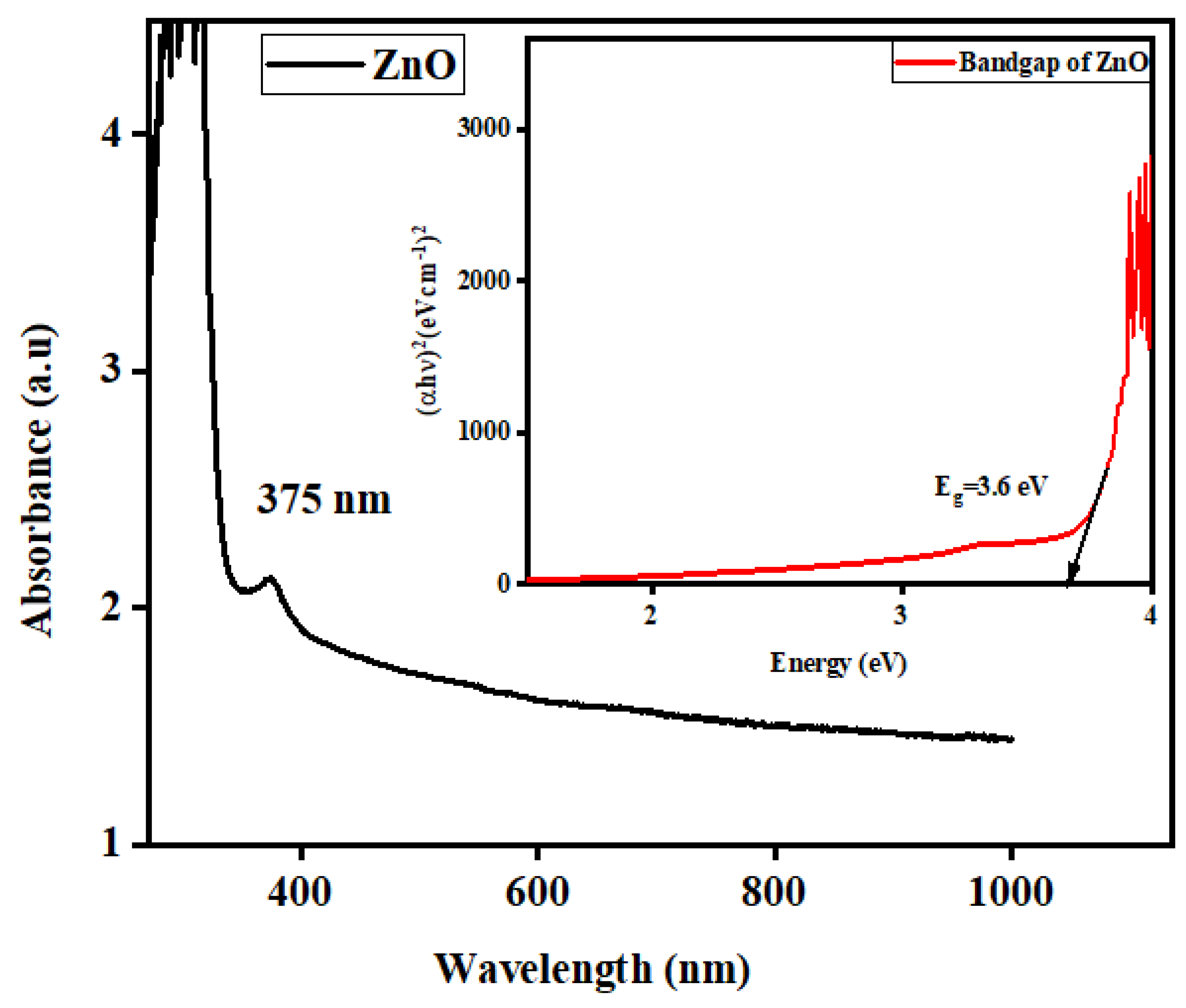

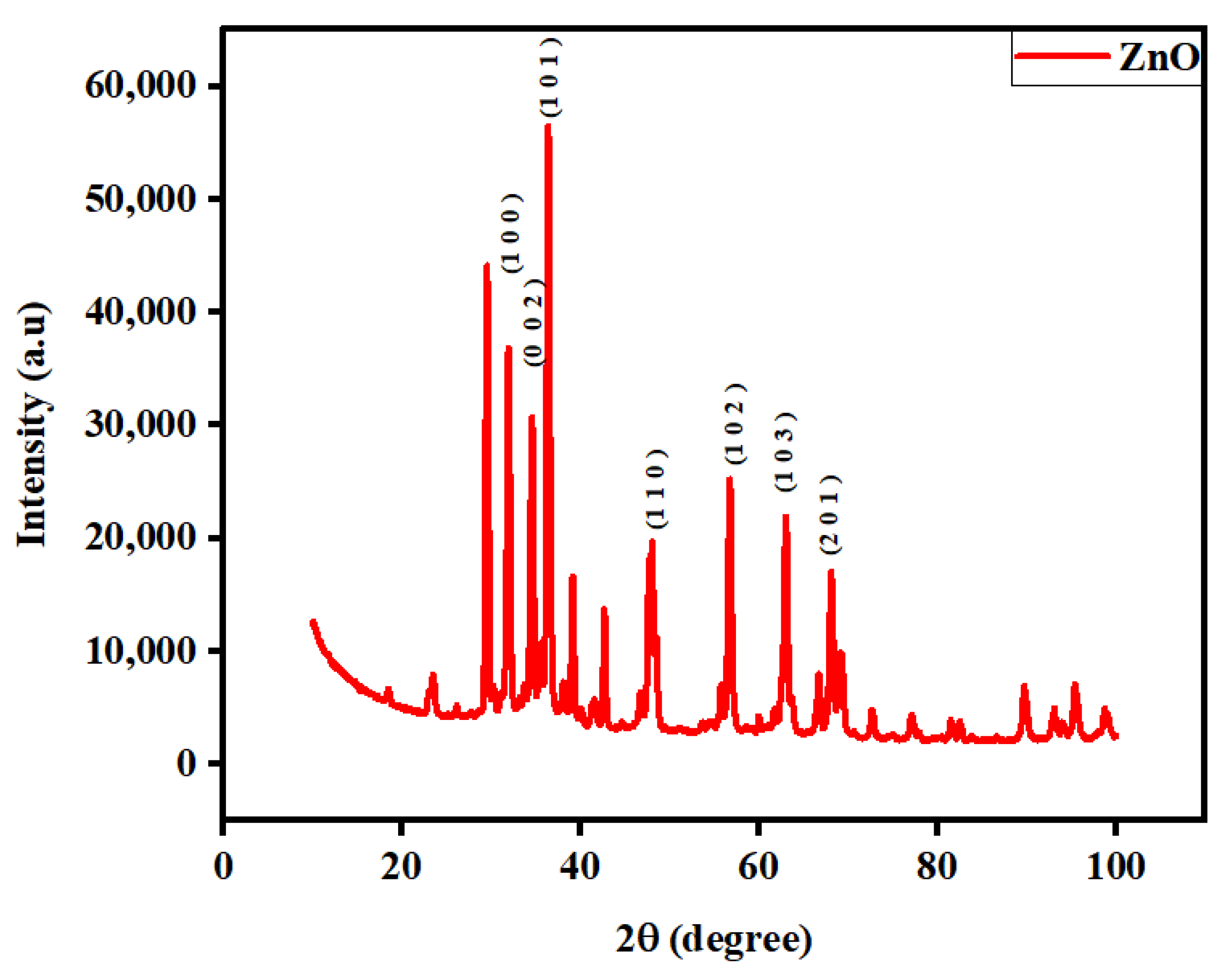
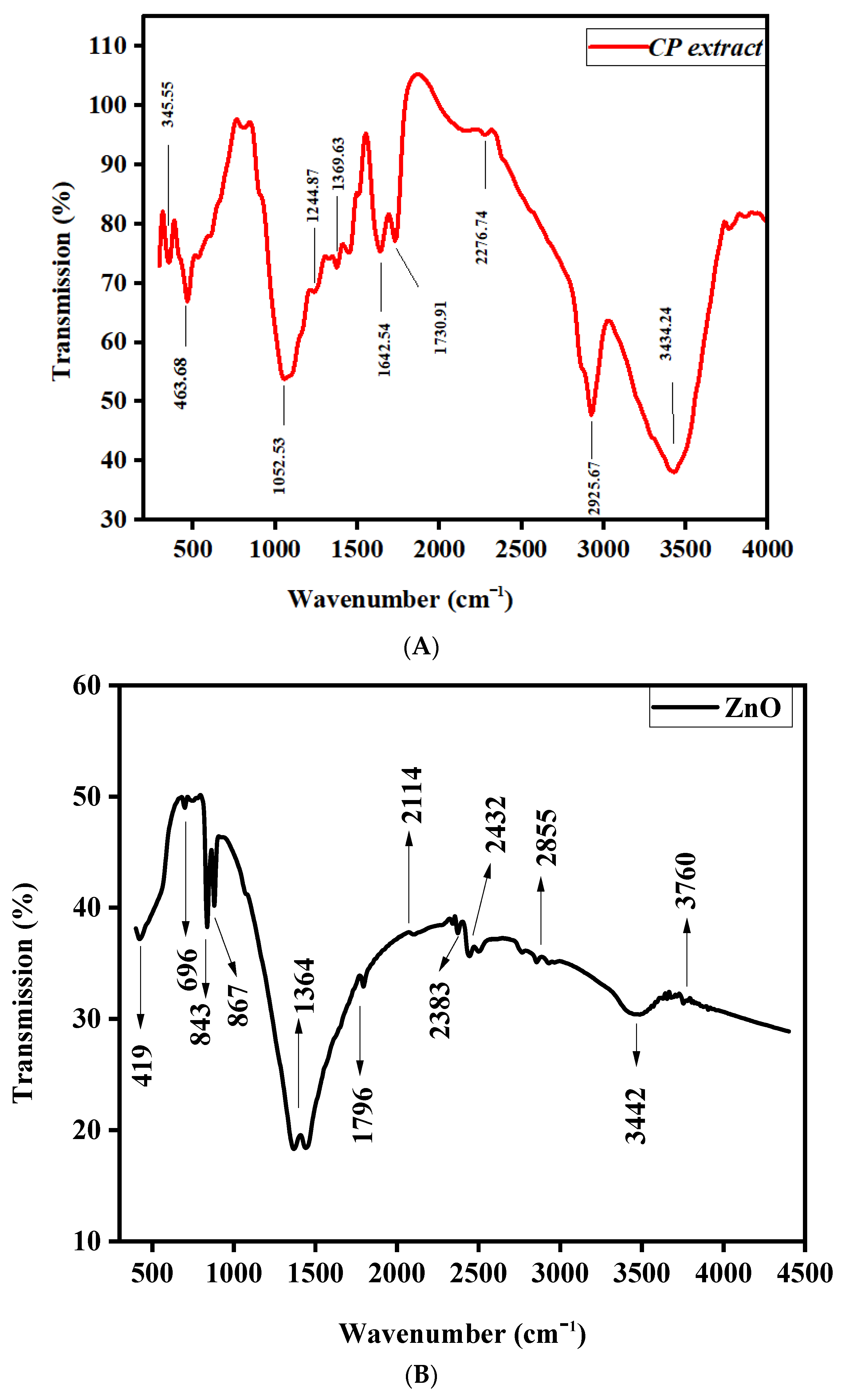
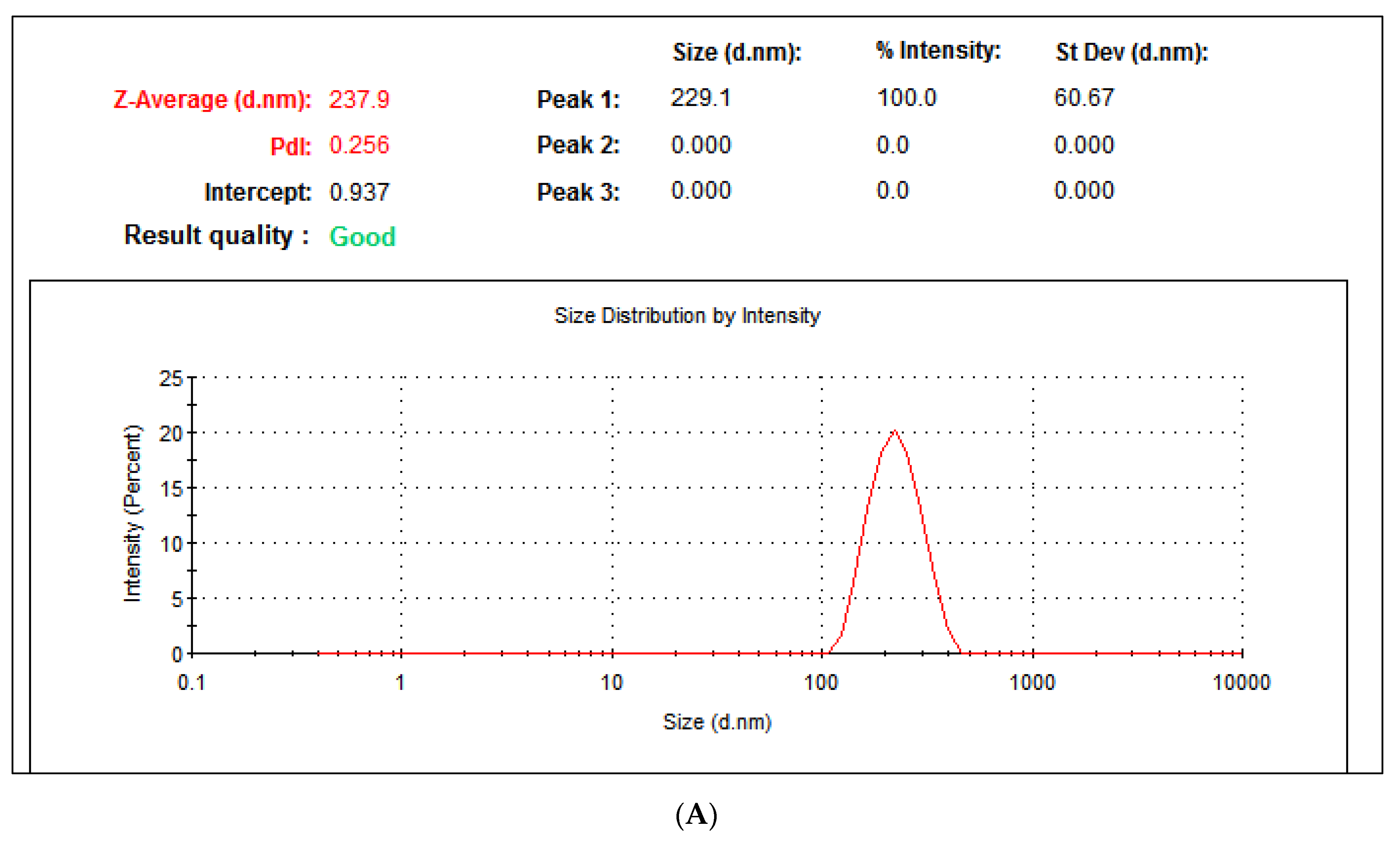
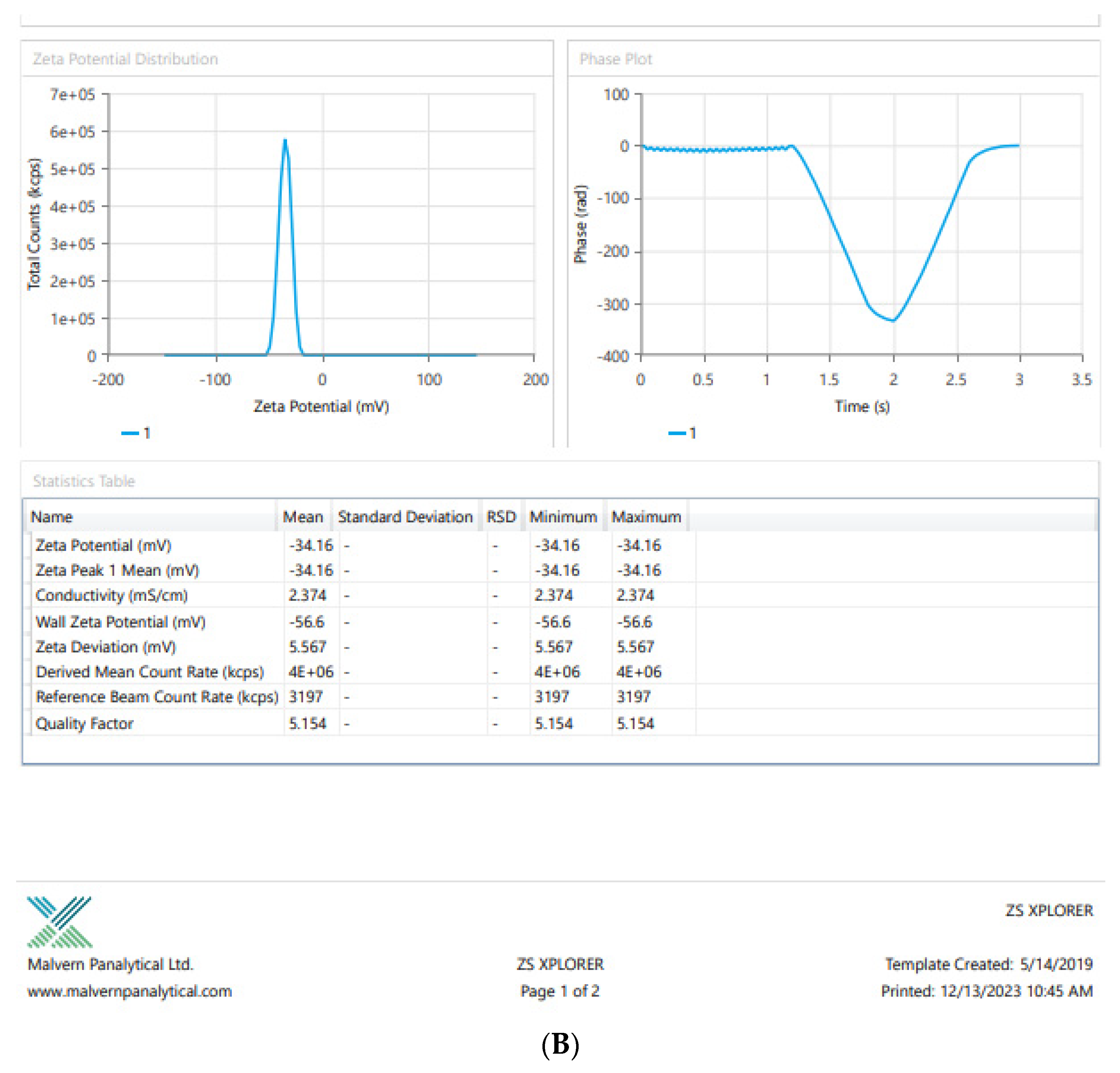

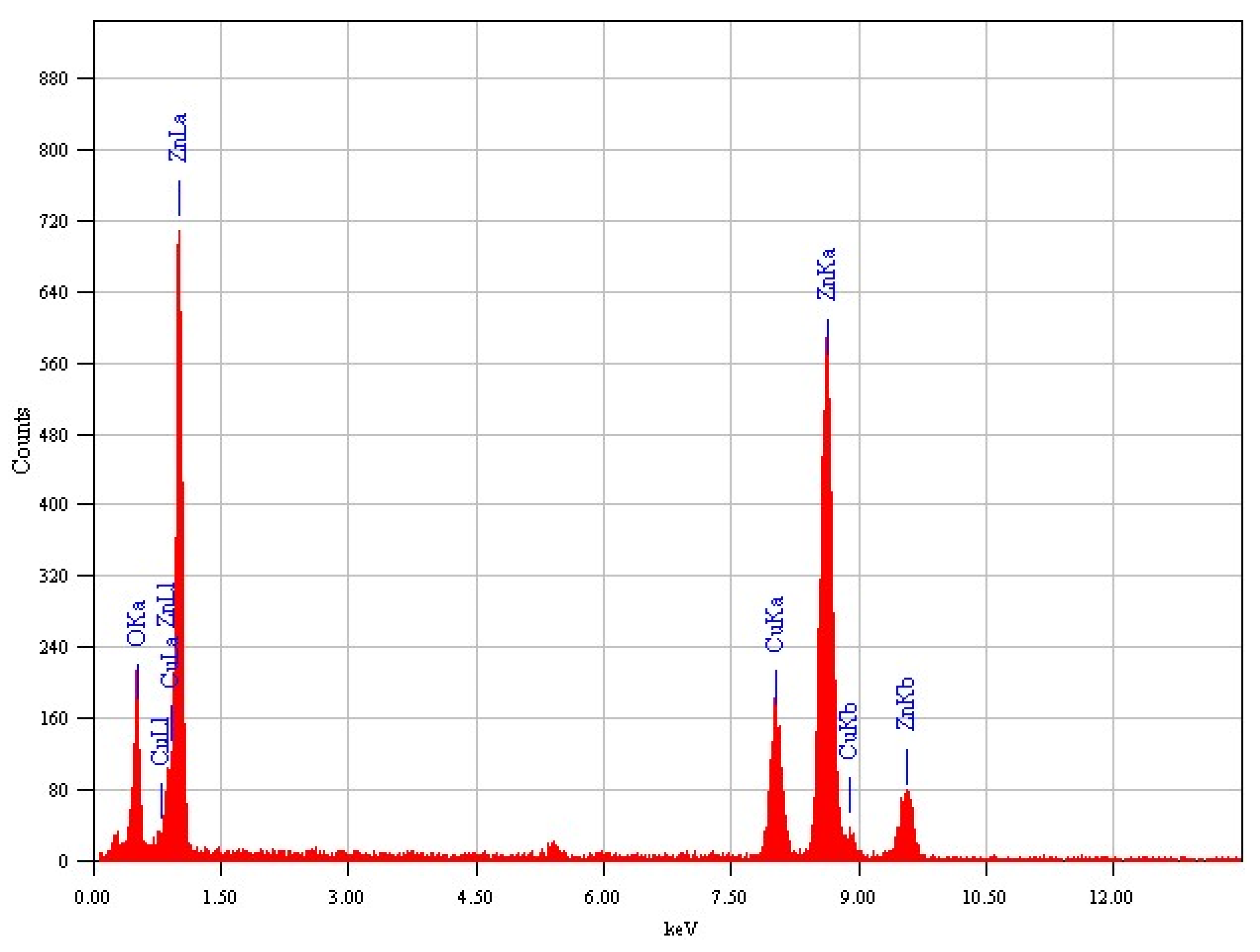
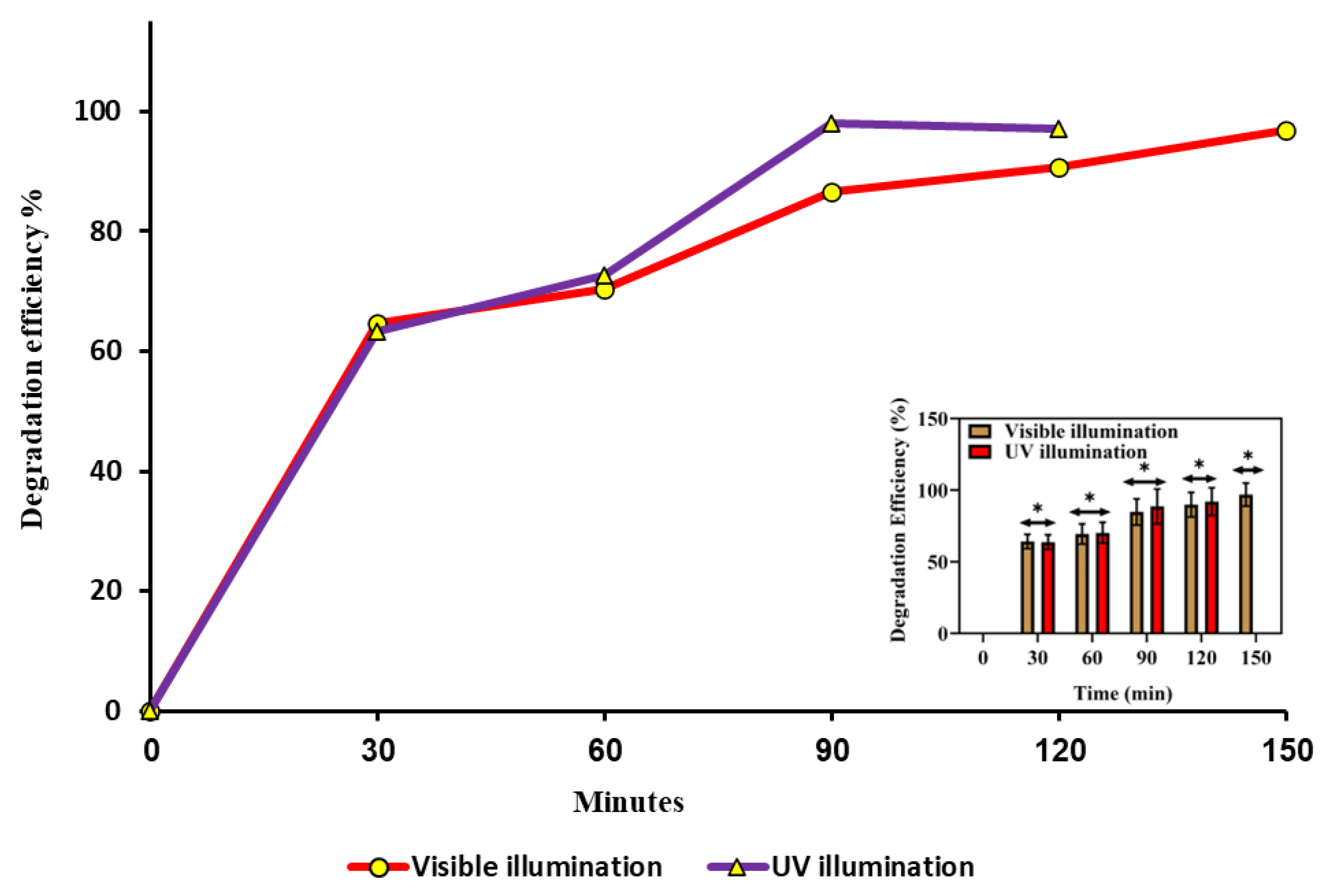

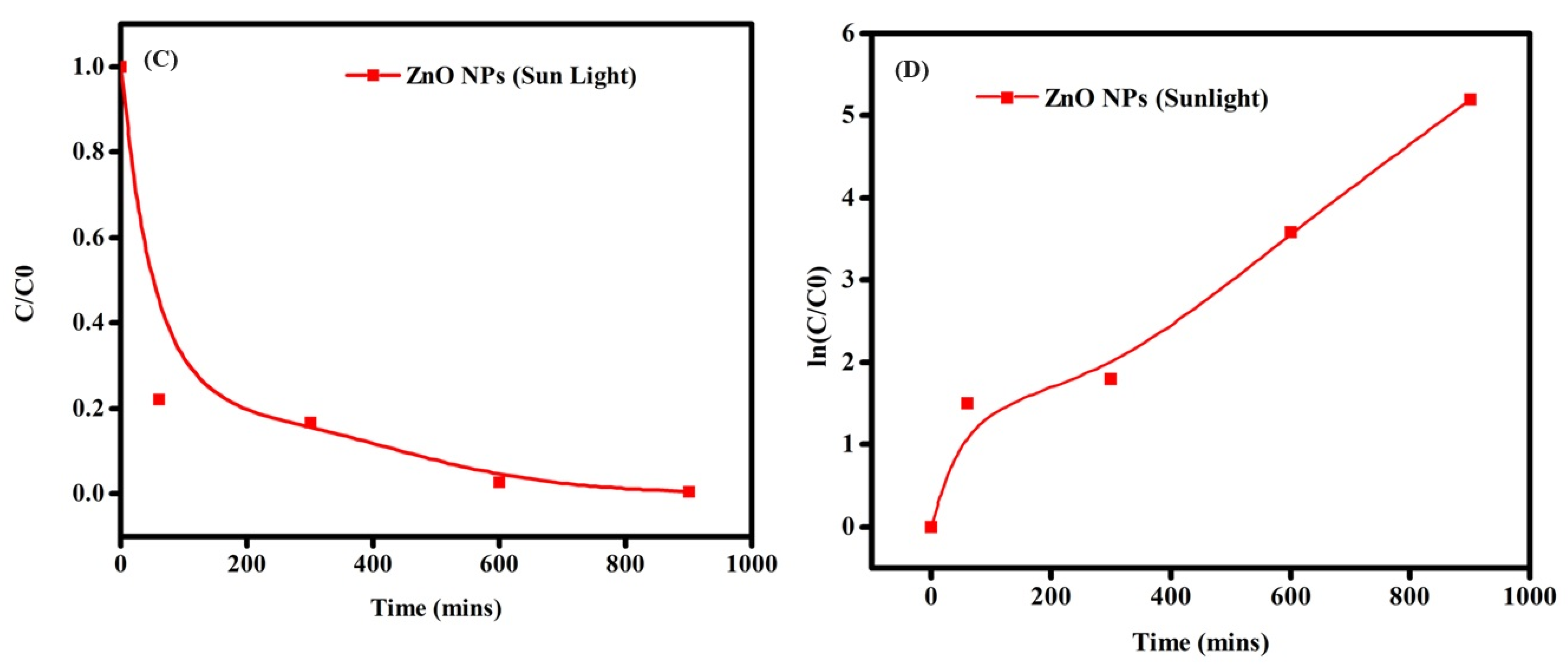

| UV Light | Visible Light | |
|---|---|---|
| Rate constants (min−1) | 0.023844 | 0.005179 |
| Half-life (units) | 29 | 134 |
| Methods of Synthesis of ZnONPs | Concentrations of Dye and ZnONPs | Light Sources and Time | Decolorization Percentage (%) of Dye |
|---|---|---|---|
| Sol-gel method | 20 mg/L dye and 0.3 g/L of ZnONPs photocatalyst | UV lamp—~150 min | [72] 88% for Congo red, 73% for Acid Blue and 70% for Coomassie Brilliant Blue R-250 |
| Precipitation method | 0.025 mg/120 mL distilled water of Orange G Orange G, and 5 mg of ZnONPs | Sunlight light—48 h | [73] 82% |
| Electrochemical method | 100 mg of ZnONPs in 100 mL of dye solution | UV irradiation | [74] 92% |
| Gel combustion method | 10 mg·L−1 of methyl orange, and 50 mg of LaxZn1−xO | Visible light—150 min | [75]~85% |
| Green synthesis method | Methyl Blue was tested at concentrations of 0.06 mg/mL and 0.03 mg/mL in combination with two different concentrations of ZnO nanoparticles (0.2 mg/mL and 0.1 mg/mL) | UV light radiation-about 40 min | [76] The higher concentration of ZnO nanoparticles (0.2 mg/mL) resulted in a degradation of 92% in the dye, whereas the lower concentration of ZnO (0.1 mg/mL) led to a reduced dye degradation of 83% |
| Cymbopogon Proximus grass extract (this study) | 10 mg/L of RhB dye and 0.1 mg of ZnONPs | Natural sunlight for 16 h or ultraviolet light for 160 min | 97% |
Disclaimer/Publisher’s Note: The statements, opinions and data contained in all publications are solely those of the individual author(s) and contributor(s) and not of MDPI and/or the editor(s). MDPI and/or the editor(s) disclaim responsibility for any injury to people or property resulting from any ideas, methods, instructions or products referred to in the content. |
© 2024 by the authors. Licensee MDPI, Basel, Switzerland. This article is an open access article distributed under the terms and conditions of the Creative Commons Attribution (CC BY) license (https://creativecommons.org/licenses/by/4.0/).
Share and Cite
Awad, M.A.; Hendi, A.A.; Ortashi, K.M.O.; Alnamlah, R.A.; Alangery, A.; Ali Alshaya, E.; Alshammari, S.G. Utilizing Cymbopogon Proximus Grass Extract for Green Synthesis of Zinc Oxide Nanorod Needles in Dye Degradation Studies. Molecules 2024, 29, 355. https://doi.org/10.3390/molecules29020355
Awad MA, Hendi AA, Ortashi KMO, Alnamlah RA, Alangery A, Ali Alshaya E, Alshammari SG. Utilizing Cymbopogon Proximus Grass Extract for Green Synthesis of Zinc Oxide Nanorod Needles in Dye Degradation Studies. Molecules. 2024; 29(2):355. https://doi.org/10.3390/molecules29020355
Chicago/Turabian StyleAwad, Manal A., Awatif A. Hendi, Khalid M. O. Ortashi, Reema A. Alnamlah, Asma Alangery, Eman Ali Alshaya, and Saad G. Alshammari. 2024. "Utilizing Cymbopogon Proximus Grass Extract for Green Synthesis of Zinc Oxide Nanorod Needles in Dye Degradation Studies" Molecules 29, no. 2: 355. https://doi.org/10.3390/molecules29020355





